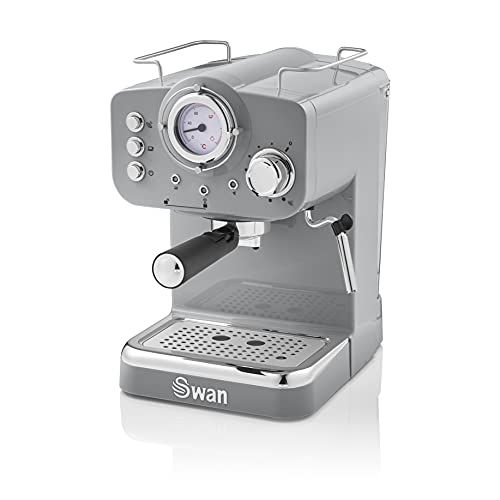Coffee and Espresso Machines

Espresso machines use pressure to push water through finely ground and tamped coffee beans. They create a rich and delicious cup of coffee.
Good Housekeeping Institute experts recommend models that can be brewed with a minimum of 9 bars to ensure a perfect extraction. Beware of brands that advertise more pressure than is required.
Types
The espresso machine (also known as a coffee and Espresso maker) produces coffee that is more concentrated, of higher quality, than the typical coffee drinks at the cafe. It makes use of an average of nine bars of pressure. These machines usually have various features, including temperature and brew strength control with programmable brewing as well as multiple drink sizes. They could also have manual or automatic steam wands to create texturized milk for latte art. There are three main types of semi-automatic, super-automatic, and automated. Each espresso machine comes with its own particular level and kind of automation.
The most popular espresso machine used in specialty coffee shops is semi-automatic models. Semi-automatic espresso machines permit baristas complete control over the brewing process, but aren't as user-friendly as fully automatic or automated machines. You must still grind beans, fill and tamp the portafilter and alter the extraction time to achieve the best quality espresso shot.
Automated machines have an integrated grinder which measures and mill the grounds for you. They automatically dispense enough water to extract espresso, and are often equipped with the capacity to programate the size of the beverage. They were the most frequent espresso machine type in our lab tests, and they provide a great level of consistency as well as human control.
Functions
There will be a need for a reservoir that can hold the water that you use to make coffee, regardless of whether you opt for a steam-driven or pump-driven machine. You'll also have a heating device that heats the water to create the pressure necessary to extract the coffee from the grounds.
When the button to brew is hit to brew, the water inlet valve is sealed so that only hot water with intense pressure can flow through the portafilter and into the ground coffee. dual boiler espresso machine will take about 25 seconds before it turns into espresso.
The hot-water tubing, also known as the insulated tubing, runs from the reservoir up to the spout at top of your machine. The resistance heating element heats the water while it goes through the warming plate of metal and the aluminum tube.
After the spout has been turned on the cup, place it under the spout so that the espresso flows into your cup through the portafilter. The coffee maker also include a steam wand that you can use to heat and froth milk for drinks made with espresso, like cappuccino or latte.
Automatic machines take the guesswork out brewing. They are easy to operate, programmable and can measure and grind beans, as well as to tamp down. They tend to have the best overall performance in our Lab tests, since they are simple to operate and don't require any user expertise.
Materials
The inside of an espresso machine is a veritable forest of copper tubes boilers made of stainless steel, and sophisticated firmware. Although they might appear to be complicated, their basic function is to make hot water into finely ground coffee.
When purchasing an espresso machine it is important to consider the size and space requirements, as along with drink options, energy saving options, and brewing accuracy. Look for a button that can be used to activate the steam wand. This is used to create latte arts and frothing milk. A gauge of pressure on the front of the machine will let you know the boiler and pump operating pressure. You should choose the coffee maker that has two needles that show the pressures that are minimum and maximum.
If you are looking for more than only espresso, choose the machine that comes with different sizes of brew. This includes the ristretto. There are models that have the option of a frothing hopper with a removable hopper that makes it easy, hands-free frothing. You can also switch between different types milk easily. If you have hard water, choose an espresso machine with a built-in softener to prevent mineral buildup and keep your espresso tasting fresh.
Certain manufacturers employ a PID (proportional integral, integral, digital) thermostat to keep a specific temperature range for espresso making. This feature helps ensure a consistent, high-quality cup of espresso each time. This feature can also help reduce cost of energy since the machine only functions when necessary.
Maintenance
As espresso and coffee machines are becoming more readily available to home use, the regular maintenance of the equipment is becoming more important. The right equipment can make a world of difference to your cup of coffee, but it's only true if the machine is working properly.
Regular maintenance and cleaning should include everything from cleaning the group head, steam wand and water filter to descaling and changing the water filters frequently. As a general rule for making between two and five cups of coffee every day, you should clean most parts of the machine at least once a week. Some parts of the machine will require cleaning every two to three weeks, for instance, the water tank and the grinder.
It is recommended to backflush the machine every week. This is done by locking the portafilter in place and running the brew cycles many times. This can help to eliminate any coffee grounds or oils left behind. You can also use a brush or cleaner designed specifically for espresso machines to clean the portafilter.
Maintaining your coffee machine and espresso properly will help it last longer. It is important to take care of your expensive espresso machine.
